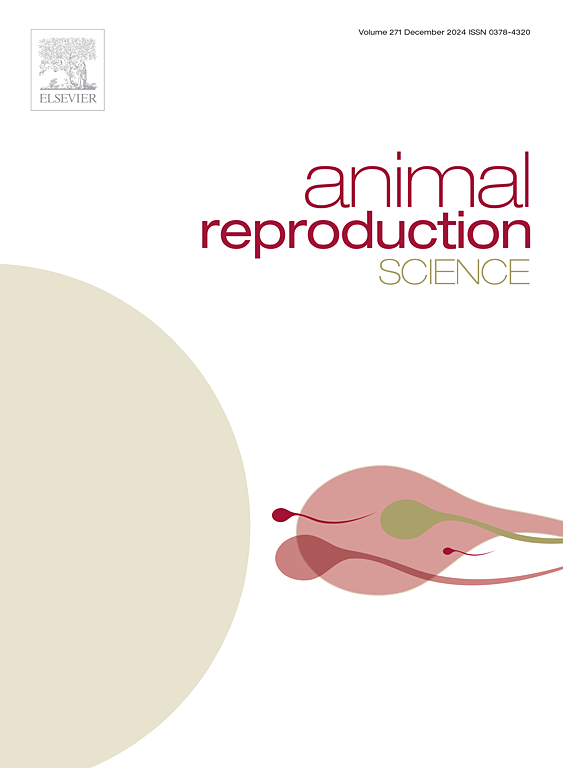Ovarian superstimulation for in vitro embryo production based on Anti-Müllerian hormone phenotype: Effect of FSH dose schedule
IF 3.3
2区 农林科学
Q1 AGRICULTURE, DAIRY & ANIMAL SCIENCE
引用次数: 0
Abstract
Anti-Müllerian hormone (AMH) is positively associated with embryo production, yet it also reflects underlying physiological variability. While follicle-stimulating hormone (FSH) is typically administered using a decreasing dose schedule, the effects of alternative dosing strategies on in vitro embryo production (IVEP) outcomes remain unclear. This study aimed to evaluate the impact of FSH dose schedule on IVEP outcomes in the context of differing AMH concentrations. Pregnant heifers (n = 22) received 350 IU of FSH across six administrations using decreasing, constant, or increasing dose schedules in a crossover design. Superstimulation began at follicular wave emergence, and cumulus-oocyte complexes (COCs) were retrieved 44 h after the last FSH dose and subjected to IVEP. Circulating AMH was positively associated with total follicle number, whereas follicle count did not differ by treatment (P ≥ 0.20). The increasing dose schedule tended (P ≤ 0.10) to yield more COCs and resulted in a greater COC retrieval percentage (P = 0.02) than the decreasing schedule. Both COC number and retrieval percentage were positively associated with AMH (P ≤ 0.03), independent of dose schedule. Greater AMH was linked to greater cleavage (constant and decreasing, P < 0.01) and blastocyst percentages (constant only, P < 0.01), while both parameters decreased with AMH under the increasing schedule (P ≤ 0.05). Despite these interactions, blastocyst yield was unaffected by FSH dose schedule (P = 0.84) but was positively associated with AMH (P < 0.01). In conclusion, AMH was predictive of IVEP outcomes regardless of FSH dose schedule, and use of a constant dose schedule may simplify donor management without compromising embryo yield.
基于抗勒氏激素表型的卵巢超刺激体外胚胎生成:FSH剂量计划的影响
抗勒氏杆菌激素(AMH)与胚胎产生呈正相关,但它也反映了潜在的生理变异性。虽然卵泡刺激素(FSH)通常使用递减剂量计划,但替代给药策略对体外胚胎产生(IVEP)结果的影响尚不清楚。本研究旨在评估不同AMH浓度下FSH剂量计划对IVEP结果的影响。在交叉设计中,怀孕的小母牛(n = 22)在减少、恒定或增加剂量的情况下,分六次给药,接受350 IU的卵泡激素。在卵泡波出现时开始过度刺激,在最后一次FSH剂量44 h后回收卵丘-卵母细胞复合物(COCs)并进行IVEP。循环AMH与总卵泡数呈正相关,而不同治疗的卵泡数无差异(P ≥ 0.20)。增加剂量方案(P ≤ 0.10)比减少剂量方案产生更多的COC, COC回收率(P = 0.02)更高。COC数和检出率与AMH呈正相关(P ≤ 0.03),与给药方案无关。更高的AMH与更高的卵裂率(恒定且减小,P <; 0.01)和囊胚率(仅恒定,P <; 0.01)相关,但随着AMH的增加,这两个参数都降低(P ≤ 0.05)。尽管存在这些相互作用,但囊胚产量不受FSH剂量计划的影响(P = 0.84),但与AMH呈正相关(P <; 0.01)。总之,无论FSH剂量计划如何,AMH都可以预测IVEP的结果,使用恒定剂量计划可以简化供体管理,而不会影响胚胎产量。
本文章由计算机程序翻译,如有差异,请以英文原文为准。
求助全文
约1分钟内获得全文
求助全文
来源期刊

Animal Reproduction Science
农林科学-奶制品与动物科学
CiteScore
4.50
自引率
9.10%
发文量
136
审稿时长
54 days
期刊介绍:
Animal Reproduction Science publishes results from studies relating to reproduction and fertility in animals. This includes both fundamental research and applied studies, including management practices that increase our understanding of the biology and manipulation of reproduction. Manuscripts should go into depth in the mechanisms involved in the research reported, rather than a give a mere description of findings. The focus is on animals that are useful to humans including food- and fibre-producing; companion/recreational; captive; and endangered species including zoo animals, but excluding laboratory animals unless the results of the study provide new information that impacts the basic understanding of the biology or manipulation of reproduction.
The journal''s scope includes the study of reproductive physiology and endocrinology, reproductive cycles, natural and artificial control of reproduction, preservation and use of gametes and embryos, pregnancy and parturition, infertility and sterility, diagnostic and therapeutic techniques.
The Editorial Board of Animal Reproduction Science has decided not to publish papers in which there is an exclusive examination of the in vitro development of oocytes and embryos; however, there will be consideration of papers that include in vitro studies where the source of the oocytes and/or development of the embryos beyond the blastocyst stage is part of the experimental design.
 求助内容:
求助内容: 应助结果提醒方式:
应助结果提醒方式:


